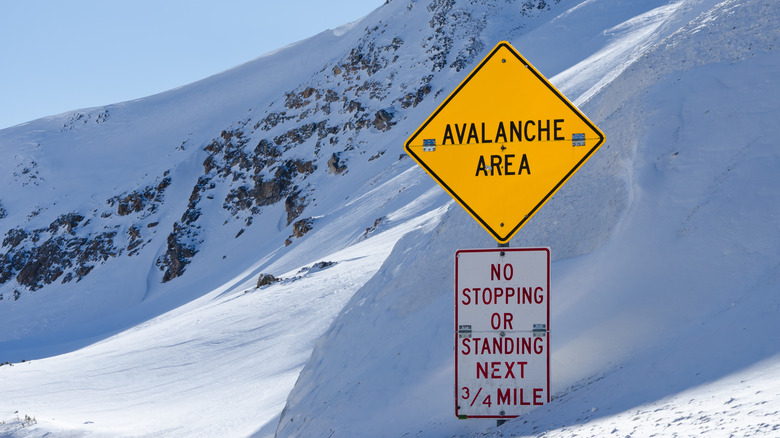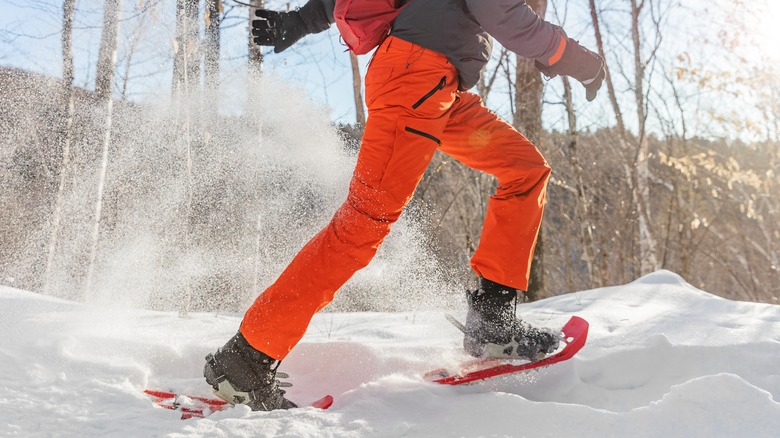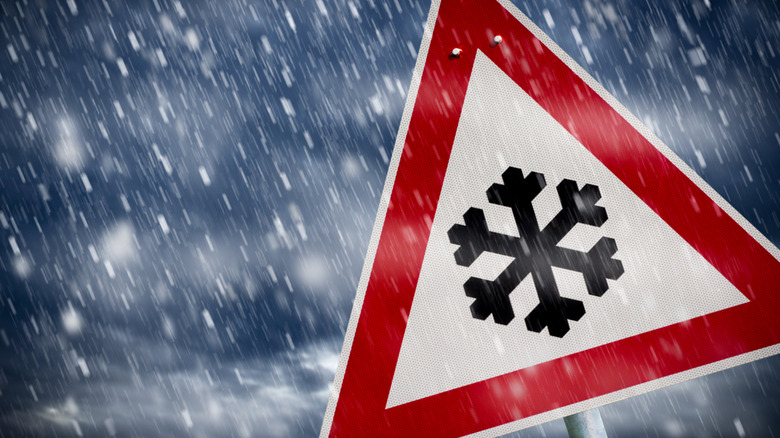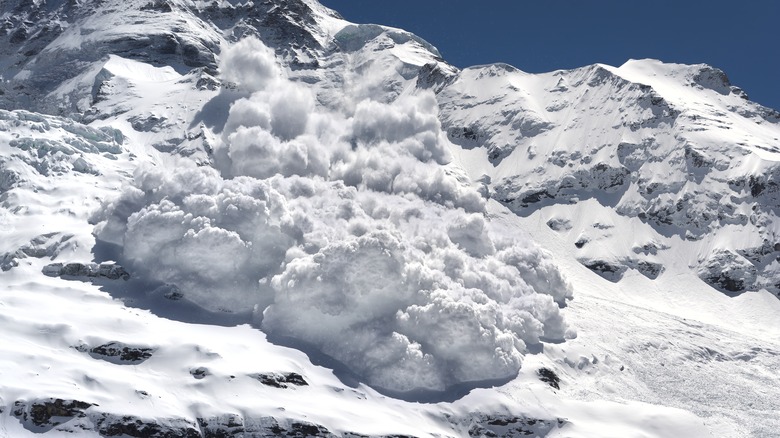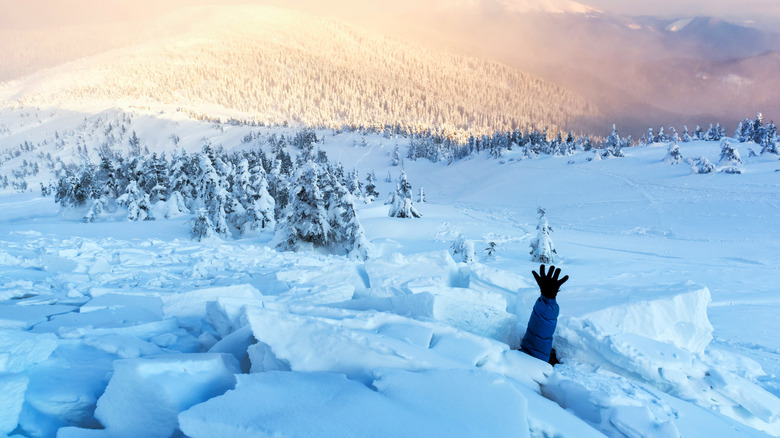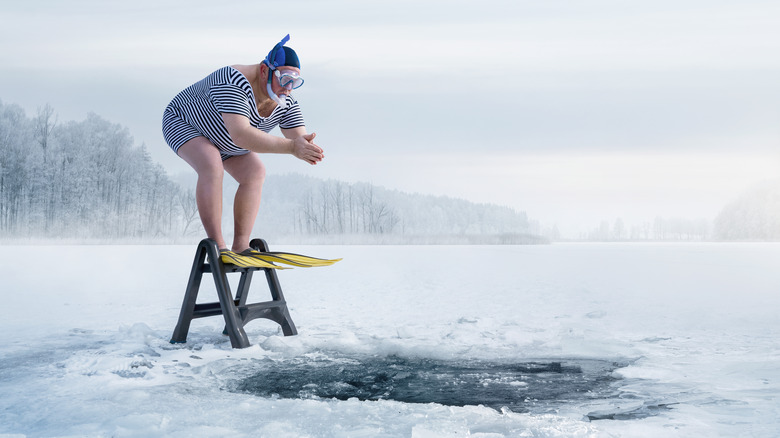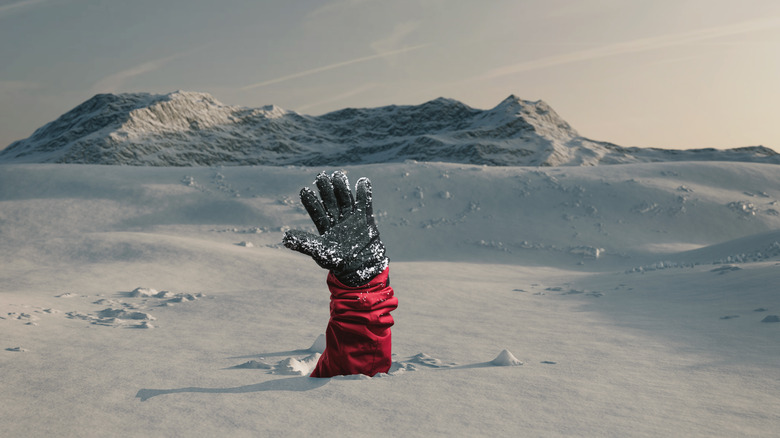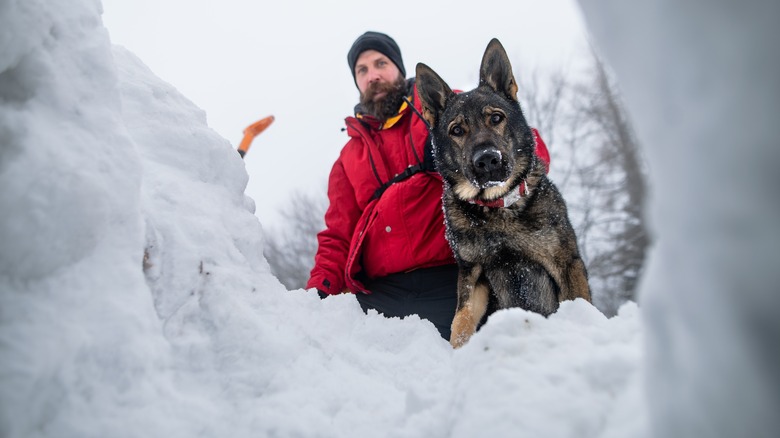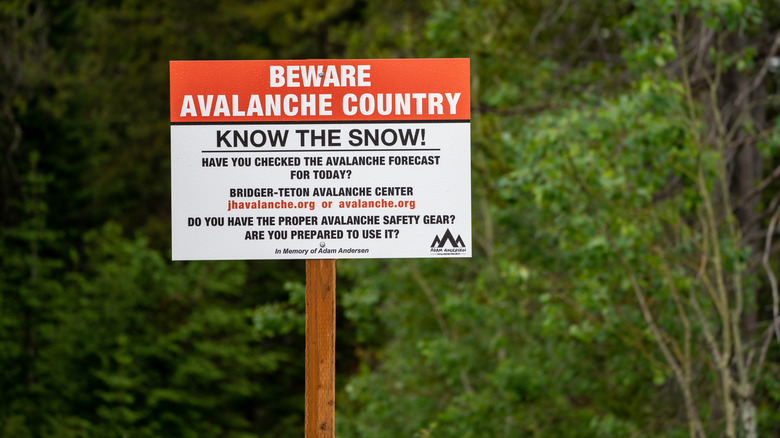What To Do If You're Caught In An Avalanche
Depending on where you spend most of your time, an avalanche may not be something you keep in mind as something to watch out for whenever you embark on a hiking trip. However, avalanches are among the most common ways people die in the wilderness. They're so common that in the United States, an average of 28 people die per year in avalanches (via FEMA). At times, even those familiar with an area where an avalanche can occur don't know what to do if that heaping tsunami of snow comes racing their way.
Don't let the possibility of an avalanche deter you from enjoying beautiful mountainous areas, as these powerful snowslides don't come out of nowhere. Certain conditions are favorable for avalanches, including recent snowstorms, steep slopes, heavy snowfall, wind direction, varying layers of snow, human activity, and an increase in temperature that can loosen the layers of snow and ice. To keep yourself alive and well, it's crucial to be well-informed on what to do if you're participating in outdoor activities and wind up caught in an avalanche.
Move out of the way
This one is the best-case scenario for avoiding an avalanche. If there's enough time for you to pick up on any warning signs, the first thing you should do is try your hardest to clear the area quickly. This is the best-case scenario because not only can avalanches be petrifying in size, but as they plummet down a mountain, picking up more snow, trees, and anything else in their path, they grow increasingly fast. A fully developed avalanche can move at over 200 miles per hour.
If you're able to move out of the way, move to the side and get as far as you can from the path of destruction. Wherever you do move, make sure you're not close to any unstable, heavy objects such as snowmobiles. You don't want to increase your odds of being taken out by a heavy projectile. So, if you're outdoors in an avalanche-prone area, no matter what it is you're up to, if you see the warning signs, get out of there as quickly as possible.
Hold on tight
Since successfully moving out of the way is entirely dependent on factors like a person's location and the speed of the avalanche, there's a possibility that removing oneself from the path of destruction isn't feasible. In this case, it's time to move on to the next step, holding on tight. This may not sound ideal, but no one said getting caught in an avalanche was an ideal situation.
Holding on tight means hanging on to anything sturdy. There likely won't be much time to look around or find a new spot so preference should go to whatever the most sturdy object is in your vicinity. This may look like a large tree, rock, or a tree branch. Avoid holding on to things that could be swept away or flipped, like vehicles. Once you've found a promising place to cling to, get in a position that you can be in for a lengthy time, as there's a chance you'll be there for a while.
Brace yourself for impact
After the realization that you're going to be caught in an avalanche hits you, the avalanche itself will soon follow. Once you're holding on tight to a sturdy object, the next step is to brace for impact. This isn't the same as holding on tight. Holding on will hopefully prevent you from getting swept away at the mercy of a wave of snow. Bracing for impact is a way to prepare your body for what's to come.
Be sure to keep your mouth closed tight and your teeth clenched. If you've packed for a hike, you're likely wearing a backpack. So, to protect your head, use your body by reaching your arm across your body, grabbing your backpack strap, and tucking your head in your elbow. If you don't have a backpack on, do your best to protect your head with your arm or your body. When you know an avalanche is going to hit you, it's understandable to feel frantic. Still, it's important to do whatever you can to minimize your risk of injury or death and maximize your chances of getting off the mountain with your life. So hang on and brace for impact.
Create an air pocket and lend a hand
Much of staying safe if you're caught in an avalanche depends not only on how much time you have to prepare but on the severity of the avalanche as well. According to the North American Public Avalanche Danger Scale, there are five levels of avalanche danger, starting from a "generally safe avalanche condition" and moving upward in severity to "extraordinarily dangerous avalanche conditions."
Creating an air pocket in front of your face may only be effective in a mild avalanche, but if time allows, an attempt should be made. Over 85% of avalanche deaths are due to asphyxiation, (via The National Library of Medicine). As the avalanche begins to slow, create an open space in front of your mouth for breathing. This will slow the buildup of carbon dioxide as you breathe under the snow. Raise one hand in the air, above the surface of the snow to let rescue teams know your location. This will hopefully get you removed from the snow much quicker.
Just keep swimming
Once amid an avalanche, there's a high chance you'll start to move down the mountain with it. When this happens, the best thing to do is try your hardest to remain on the surface to avoid debris and getting buried deep under the weight of the snow. To do this, move your body in a swimming motion and swim with the current.
This may seem silly, but the idea is to stay near the snow's surface and at the tail-end of the avalanche. The tail-end is safer compared to the front because you're less likely to be slammed into random objects on the snow slide's path of destruction. There's also a higher likelihood of being buried further down in the snow if you're caught at the head of an avalanche. According to an International Snow Science Workshop, this method has been questioned regarding its ability to help or hinder a person in this survival situation. Though without evidence supporting it as an incorrect method, it continues to be recommended as a means of action in an avalanche.
Push yourself upward and don't panic
Eventually, the rolling snow and debris will begin to slow, and you may get an opportunity to realize whether you're fully submerged. When this slow-down occurs, try to push yourself upward toward the surface. If you can get your head above the snow, do so. If not, at least try to raise a hand for visibility. Whether you can or can't get to the surface, the most critical piece to remember is not to panic.
Panicking will increase your heart rate and lead to more rapid breathing. If you're trapped under the snow with an air pocket, rapid breathing will only fill it with carbon dioxide at a more rapid pace. This will have a detrimental impact on the amount of oxygen and time you have left for rescuers to find you before you succumb to asphyxiation. Once an avalanche begins to slow, it's still a deadly situation. Nevertheless, maintaining a clear thought process and knowing what to do could save your life.
Try to dig yourself out
If you find yourself buried in the snow, there's a high chance your mobility will be limited. However, on the off chance that you're able to move well, or at all, you can take the opportunity to attempt digging yourself out of the snow. If you can dig your whole body out, do so. It's likely, though, that even if you can move and dig yourself out even part of the way, part of you will remain lodged under the surface of the snow with little to no mobility.
Even with partial exposure, this will greatly increase your chances of being found, thanks to visibility. If you can't dig yourself out or you can only get part-way out of the snow heap, remember not to panic. If you see or hear the rescue team nearby, call for help to let them know you're in the area. If you don't see or hear them, don't waste your energy, or oxygen if you're still buried.
Avalanche preparedness
The number one way to survive an avalanche is not getting caught in one in the first place. If you're venturing outdoors and you know you're going to be in an area where avalanches are common or even a possibility, be prepared. Plan ahead, check conditions, know how to keep your phone from dying in the cold in case you need to call for help, and pack appropriate gear that could help you in a survival situation.
Many avalanche centers provide daily forecasts and warnings. It's also important to recognize the signs of an avalanche. If you hear loud noises coming from the snow or see a large crack in a snow slab, it may be best to get off the mountain or out of the area. Make sure to test all of your gear before going out so you know how to use it properly when time is precious. Enjoy your time in the mountains and appreciate all the beauty nature has to offer, but always put your safety in the forefront of your mind.
